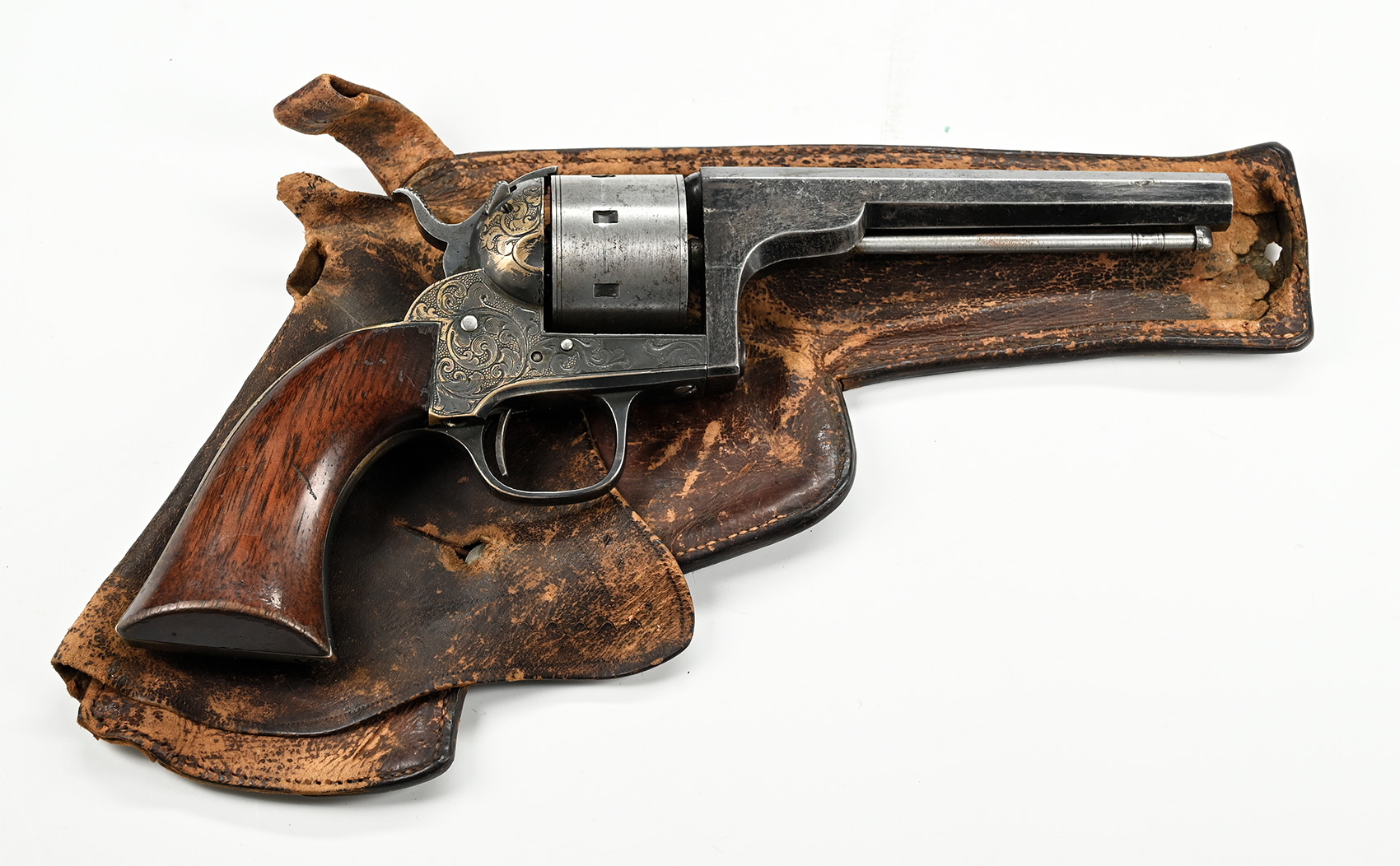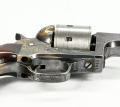site search
online catalog
HANDSOME INSCRIBED MOORE REVOLVER WITH HOLSTER OF C.H. RICHMOND

$5,500.00
Quantity Available: 1
Item Code: 2023-2603
Shipping: Determined by Method & Location of buyer
To Order:
Call 717-334-0347,
Fax 717-334-5016, or E-mail
Moore revolvers used the .32 caliber self-contained metallic rimfire cartridge, which was available and convenient. They were not subject to damage by rough handling, weather resistant, and made a pistol fast to load. Moore also provided value for the money, including floral engraving on the silver washed brass frame as a standard feature, and a bonus in the form of seven rounds in the cylinder rather than six, loaded by swinging the barrel and cylinder to the right, and cleared using a removable rod from under the barrel. From 1861 to 1863 Moore produced somewhere between 5,000 and 8,000 by Flayderman’s reckoning, before being effectively shut down for infringement on the idea of a bored-through cylinder, which was among the Rollin White patents acquired by Smith and Wesson. This one is serial number 1961, putting it reasonably early in the production run, and has a 5-inch barrel.
This is a very nice example of Moore’s work, with crisp barrel stamping, “D. MOORE PATENT SEPT. 18. 1860” and very elegant floral scroll engraving covering the frame on both sides and the lower section of the backstrap, which is professionally engraved in script, “C.H. Richmond” near the top, starting just below the fan-shell decoration under the hammer. The buttstrap and bottom of the triggerguard bow are engraved with border lines of dashes and a star in the middle of the triggerguard bow also.
All the metal has a smooth surface. The barrel has a good deal of thin blue, stronger near the cylinder and on the underside. The cylinder has lost its blue through handling and the silver wash is gone from the sides of the frame and the backstrap, again from normal handling, but there is no loss of detail to the markings or engraving and the frame and backstrap have a pleasing untouched aged brass patina. Some of the silver wash remains on the backstrap just below the hammer and is quite strong on the butt and triggerguard, and about 60 percent or better on the strap between, with some nice blue on the underside of the frame just forward of the triggerguard. The grips are excellent, with nice color, surface and fit to the metal.
The pistol comes with its original brown holster that shows wear and abrasions, with a small hole at the muzzle and some open stitching at the butt, but is complete and with a full military style flap secured by a stud. The holster is set up to hold the pistol on the wearer’s right with the butt to the rear. There appear to be no provisions for a belt loop on the reverse, but a small loop at the top forward edge suggests it may have been intended for suspension from the top edge on a narrow waist belt.
Not to be deterred from the firearms trade by the Smith and Wesson lawsuit, Moore went on to market a successful “teat-fire” revolver, whose cartridges were loaded from the front of the cylinder, which did not have to be bored-through, and was also successful with his single-shot rimfire Deringer. He also got even, to a degree, with Smith and Wesson, who settled with him out of court when he, in turn, sued them for infringing on the birdshead grip he used on his front-loading, teat-fire revolvers.
We have not identified C.H. Richmond to our satisfaction. If he was an army officer, a good candidate might be Assistant Surgeon and Surgeon, Charles H. Richmond of Albany, NY, who served in the 104th New York from August 1862 to July 1865. Surgeons were not typically armed, other than with their dress sword, but might very well possess a sidearm for personal protection. We can think of at least one example: a Colt pocket presented to a surgeon of the 5th Mass by medical school classmates in case he got into a situation that could not be dealt with by medical expertise. But, whoever Richmond was, he owned a fine revolver. [sr] [ph:m]
~~~~~~~~~~~~~~~~~~~~~~~~~~~~~~~~~~~
THIS ITEM, AS WITH ALL OTHER ITEMS AVAILABLE ON OUR WEB SITE,
MAY BE PURCHASED THROUGH OUR LAYAWAY PROGRAM.
CLICK HERE FOR OUR POLICIES AND TERMS.
THANK YOU!
Inquire About HANDSOME INSCRIBED MOORE REVOLVER WITH HOLSTER OF C.H. RICHMOND
For inquiries, please email us at [email protected]
Most Popular
Historical Firearms Stolen From The National Civil War Museum In Harrisburg, Pa »
Theft From Gravesite Of Gen. John Reynolds »
Cavalry Carbine Sling Swivel »
Fine Condition Brass Infantry Bugle Insignia »
featured item
QUARTER-PLATE AMBROTYPE AND TWO LETTERS OF CONFEDERATE OFFICER RUNNELS DAVIS, WHO DIED OF WOUNDS RECEIVED AT THIRD WINCHESTER
Runnels Davis was born June 1, 1835. He was the first-born son of Alfred Ward Grayson Davis who was a roommate and third cousin, once removed, of future Confederate President Jefferson Davis at West Point. Alfred Davis left West Point before… (846-521). Learn More »















